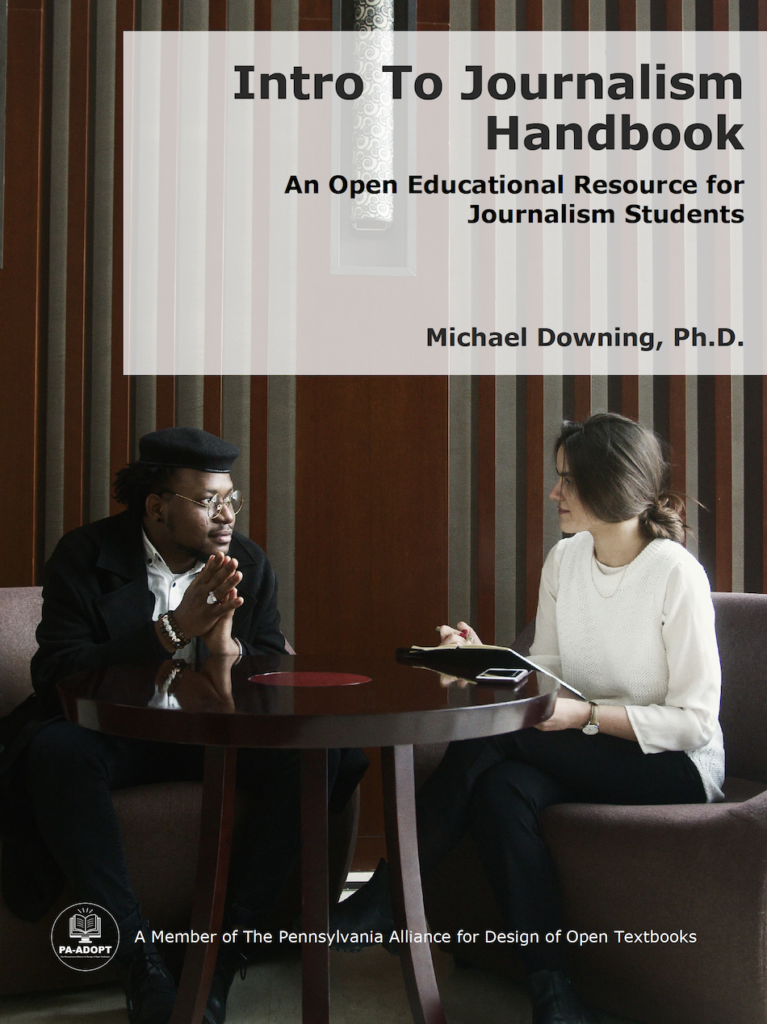Intro to Journalism Handbook: An Open Educational Resource for Journalism Students
by Michael Downing, Ph.D.
Keywords: Journalism, Writing, News, Reporting, Newspapers

About the Book
This book is intended as an open educational resource for beginning journalism students. It contains information on such topics as the First Amendment, 5 Ws (and H), the inverted pyramid, headlines and subheads, AP and in-house style, writing and editing exercises, and guidance on strategies for covering various stories and/or events.
This book essentially replicates the structure of the author’s journalism classes, which are writing-intensive classes. As such, it focuses upon helping student writers begin working on reasonably serious, campus-level journalism assignments as quickly and effectively as possible. The goal is to submit stories, photos, and occasionally video to a university newspaper for publication, all the while following professional standards related to accuracy, clarity, grammar, and AP style.
Chapters
- Introduction
- Key Concepts in Journalism
- Format and Style
- Obits, Hard News, Press Releases, Sports, Options
- Checklists for Covering Various Stories
- The Impact of Social Media on Journalism
- Artificial Intelligence and Journalism
- Journalistic Code of Ethics
- Careers
- BLS: New Analysts, Reporters, Journalists
- Exercises, Self Tests, and Useful Tools
- Resources
- Appendix
General Information
- Publication Year: 2024
- Edition: Fifth
- Subject: Introductory Journalism Handbook
License

This work is licensed under a Creative Commons Attribution-NonCommercial 4.0 International License (CC BY-NC 4.0), except where otherwise noted.
Usage
Readers
The eTextbooks created as a part of this program are provided in two formats: ePub and PDF. Please refer to our Reader Support section for guidance on which format may be best for you and the device(s) you use.
Instructors
If you are an instructor seeking to use this eTextbook in your own course(s) please feel free to download the ePub and/or PDF file(s) for your use, but make sure to complete our eTextbook Usage Survey (this information is used for program evaluation purposes).
If you are interested in making revisions and edits to this eTextbook please note that this is possible since the book is under a Creative Commons License, which allows you to remix, reuse, revise, and redistribute the eTextbook. Please refer to the Faculty Support Page, specifically looking at Remixing. You can download Intro to Journalism Handbook: An Open Educational Resource for Journalism Students Apple Pages File in order to use the original document to revise and remix the eTextbook for your purposes.
Citations
MLA: Downing, Michael. Intro to Journalism Handbook: An Open Educational Resource for Journalism Students. First, The Pennsylvania Alliance for Design of Open Textbooks (PA-ADOPT), 2024.
APA: Downing, M. (2024). Intro to Journalism Handbook: An Open Educational Resource for Journalism Students. (First). The Pennsylvania Alliance for Design of Open Textbooks (PA-ADOPT).
Chicago: Downing, Michael. Intro to Journalism Handbook: An Open Educational Resource for Journalism Students. First. The Pennsylvania Alliance for Design of Open Textbooks (PA-ADOPT), 2024.
Peer Review
This eTextbook went through an Open Peer Review process. The peer review process used the Open SUNY Textbook Peer Review Guidelines, allowing peer reviewers to read the text carefully and evaluate the following:
- Educational Significance of Content including accuracy, appropriate and useful materials, valid and significant concepts, models, and skills, and key elements;
- Effectiveness as a Teaching Resource including a clear explanation of the concepts, alignment of materials to the learning process of the target audience, and alignment of the learning objectives with course goals; and
- Readability and Ease of Use including clarity and comprehensiveness, consistent writing style, readability and ease of use (logic, sequence, and flow), appropriateness for target readership level, and quality of Interactivity and multimedia learning objects.
As a part of the open peer review process, the public review conducted by Dr. Robert M. Folk is made available: Peer Review Document (PDF).